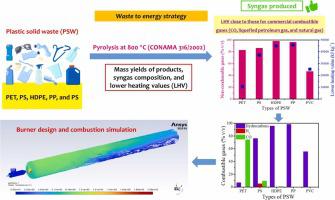当前位置:
X-MOL 学术
›
Process Saf. Environ. Prot.
›
论文详情
Our official English website, www.x-mol.net, welcomes your feedback! (Note: you will need to create a separate account there.)
Mass yields of products and composition of syngas from pyrolysis of Brazilian plastic solid wastes: Combustion simulation and burner design to minimize COx and CxHy emissions
Process Safety and Environmental Protection ( IF 7.8 ) Pub Date : 2024-04-06 , DOI: 10.1016/j.psep.2024.04.027 José S. Pessoa Filho , Bernardo A. de Souza Penha , Sarah V. Satto , Euclides A.P. de Lima , Valério L. Borges , Valdislaine M. Silva , Marcelo B. dos Santos , Alam G. Trovó , Solidônio R. de Carvalho
Process Safety and Environmental Protection ( IF 7.8 ) Pub Date : 2024-04-06 , DOI: 10.1016/j.psep.2024.04.027 José S. Pessoa Filho , Bernardo A. de Souza Penha , Sarah V. Satto , Euclides A.P. de Lima , Valério L. Borges , Valdislaine M. Silva , Marcelo B. dos Santos , Alam G. Trovó , Solidônio R. de Carvalho

|
For the first time, the mass yields of products and the composition of synthesis gas (syngas) from pyrolysis of Brazilian plastic solid waste were evaluated for a reactor processing 20 g of plastic at 800 °C. Combustion of the syngas was simulated, evaluating the levels of CO and CH emissions, and a burner was designed to minimize emissions during combustion. The main findings highlighted the importance of performing thermogravimetric analyses of waste materials. Higher thermal degradation temperatures (530–900 °C) were obtained for all the plastics, compared to values reported in the literature (300–600 °C). Between 46.7 and 98.0 wt% of syngas was produced, with lower heating values ranging from 10390 to 45684 kJ kg, due to differences between the plastics in the fractions of inorganic and hydrocarbon gases produced. The maximum temperatures for syngas combustion, simulated using ANSYS software, were 2000 and 800 °C inside the burner and combustion chamber, respectively. In the burner, higher CO and CH levels were related to the syngas composition and incomplete chemical reactions in the flame zone. The CO and CH levels decreased towards the combustion chamber, where CO was less than 8 wt%, in compliance with the CONAMA 316/2002 regulation.
中文翻译:

巴西塑料固体废物热解产生的产品质量和合成气成分:燃烧模拟和燃烧器设计,以最大限度地减少 COx 和 CxHy 排放
首次评估了在 800 °C 下处理 20 克塑料的反应器中巴西塑料固体废物热解产生的产品质量产率和合成气 (syngas) 的成分。模拟合成气的燃烧,评估二氧化碳和甲烷的排放水平,并设计燃烧器以最大限度地减少燃烧过程中的排放。主要发现强调了对废料进行热重分析的重要性。与文献报道的值 (300–600 °C) 相比,所有塑料都获得了更高的热降解温度 (530–900 °C)。由于塑料之间产生的无机气体和碳氢化合物气体的比例不同,产生了 46.7 至 98.0 wt% 的合成气,较低的热值范围为 10390 至 45684 kJ kg。使用 ANSYS 软件模拟的合成气燃烧最高温度在燃烧器和燃烧室内分别为 2000 和 800 °C。在燃烧器中,较高的CO和CH含量与合成气成分和火焰区化学反应不完全有关。 CO 和 CH 水平向燃烧室方向下降,其中 CO 含量低于 8 wt%,符合 CONAMA 316/2002 规定。
更新日期:2024-04-06
中文翻译:

巴西塑料固体废物热解产生的产品质量和合成气成分:燃烧模拟和燃烧器设计,以最大限度地减少 COx 和 CxHy 排放
首次评估了在 800 °C 下处理 20 克塑料的反应器中巴西塑料固体废物热解产生的产品质量产率和合成气 (syngas) 的成分。模拟合成气的燃烧,评估二氧化碳和甲烷的排放水平,并设计燃烧器以最大限度地减少燃烧过程中的排放。主要发现强调了对废料进行热重分析的重要性。与文献报道的值 (300–600 °C) 相比,所有塑料都获得了更高的热降解温度 (530–900 °C)。由于塑料之间产生的无机气体和碳氢化合物气体的比例不同,产生了 46.7 至 98.0 wt% 的合成气,较低的热值范围为 10390 至 45684 kJ kg。使用 ANSYS 软件模拟的合成气燃烧最高温度在燃烧器和燃烧室内分别为 2000 和 800 °C。在燃烧器中,较高的CO和CH含量与合成气成分和火焰区化学反应不完全有关。 CO 和 CH 水平向燃烧室方向下降,其中 CO 含量低于 8 wt%,符合 CONAMA 316/2002 规定。



























 京公网安备 11010802027423号
京公网安备 11010802027423号